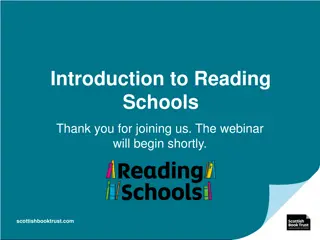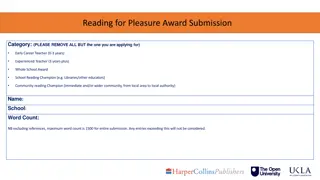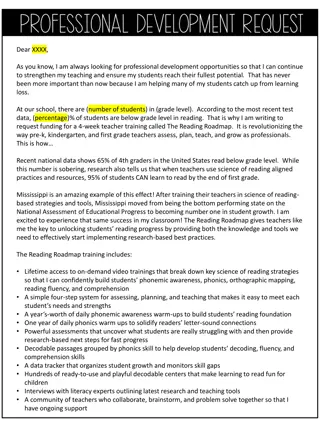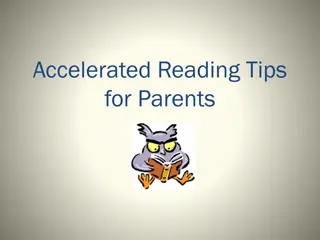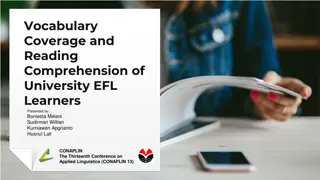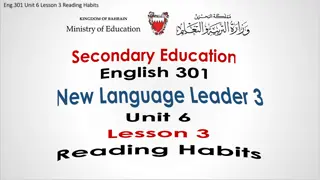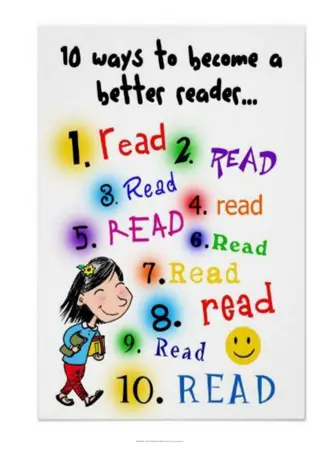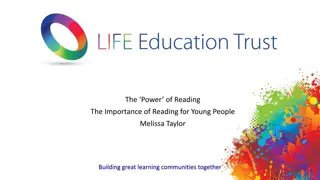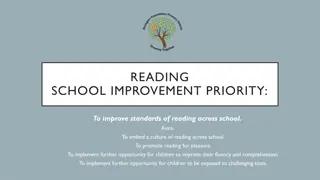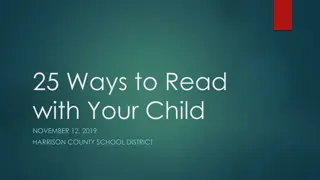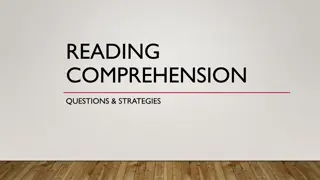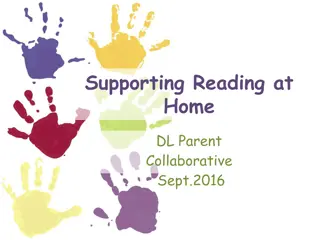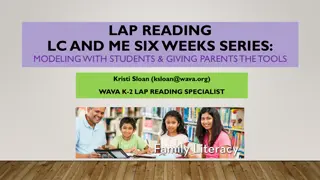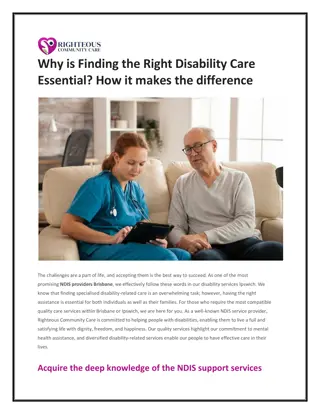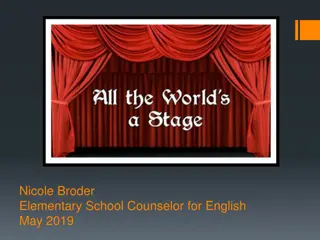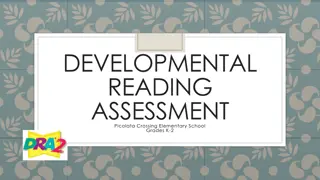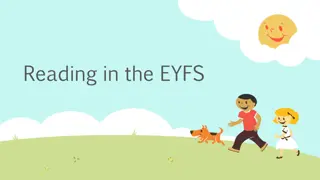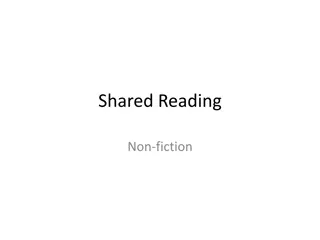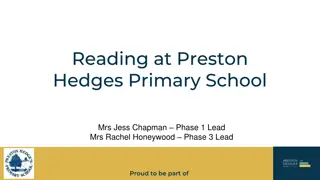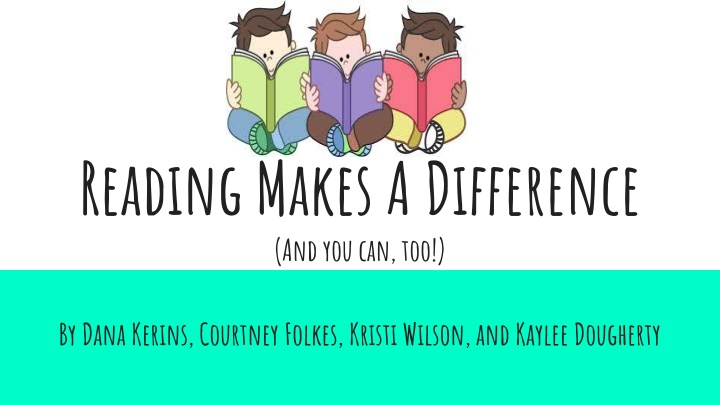
Transforming Early Childhood Literacy Through Research and Recommendations
Courtney, Dana, Kristi, and Kaylee from Boise State University conducted research on early childhood literacy in Idaho. They discovered the significant impact of home media environments, preschool home literacy practices, and library programs on children's reading skills. Their findings emphasize the importance of parental involvement, access to reading materials, and community support for young readers. The team's recommendations aim to enhance literacy outcomes for children in Idaho, particularly focusing on working parents and their access to literacy programs.
Download Presentation

Please find below an Image/Link to download the presentation.
The content on the website is provided AS IS for your information and personal use only. It may not be sold, licensed, or shared on other websites without obtaining consent from the author. If you encounter any issues during the download, it is possible that the publisher has removed the file from their server.
You are allowed to download the files provided on this website for personal or commercial use, subject to the condition that they are used lawfully. All files are the property of their respective owners.
The content on the website is provided AS IS for your information and personal use only. It may not be sold, licensed, or shared on other websites without obtaining consent from the author.
E N D
Presentation Transcript
Reading Makes A Difference (And you can, too!) By Dana Kerins, Courtney Folkes, Kristi Wilson, and Kaylee Dougherty
about us We, Courtney, Dana, Kristi, and Kaylee, are all Students attending Boise State University majoring in Health Promotion and Education. This semester we have had the wonderful opportunity to work with Sherry Iverson in drafting a needs assessment to grasp more knowledge on early childhood literacy in Idaho for our Community Health Course. We created, distributed, and analyzed surveys in order to provide valid and helpful recommendations for our presentation. We hope our recommendations will be a great source for the Pediatricians of Idaho.
What we Researched Article 1 : From ABCs to DVDs: Profiles of infants' home media environments in the first two years of life, 2013. Parents of 100 infants aged 10-19 months Parents given a demographic survey, vocabulary test, baby media test, and book cover test. Families were also observed in their homes FINDINGS: Parents who scored higher on the book cover test also scored higher on the vocab test and owned less DVDs Printed material has a big effect on vocabulary and reading skill of parents, children and families Family plays a huge role in children s language development
what we researched Article 2: Preschool home literacy practices and children's literacy development: A longitudinal analysis, 2008. 146 preschoolers from low-middle class families Parents took a Home Literacy Environment questionnaire asking about parent-child reading habits, children took letter-word identification, phonological processing, and memory tasks. FINDINGS: The more parents/children read together, the more receptive vocabularies children had, and children whose parents taught them to read scored higher on letter-word identification Reading with children and teaching them reading skills at home at an early age leads to likely proficiency in reading and comprehension skills. This can be helpful for success in future education.
What we researched Article 3: Making story time available to children of working parents: Public libraries and the scheduling of children s literacy, 2007. Top 50 US libraries according to the American Public Library Ratings 2005 Looked at whether these libraries provided children s reading programs, both during the work day, and before/after normal work hours FINDINGS: During the work day: 47 infant/toddler programs, 34 family programs. Outside the work day, out of all programs offered throughout the libraries: 500,000+ population: 11.3% infant/toddler programs, 11.8% preschool programs, 24.3% family programs Libraries saw a need for after work-hours programming to accommodate for working families, as well as alternative program options
Development of pediatrician survey Location Doctor s Office What is the challenge with media? Time spent on device Frequency of parent or infant on device How are doctor s reaching out? Talking
Pediatrician survey results 14 total responses All Pediatricians were located in the Treasure Valley Results 43% of pediatricians said they often see children on technological devices 64% of the pediatricians have prescribed reading 79% do not provide a book or a pamphlet about reading to the children s parents. However, most have books available in their waiting room. 86% do not use a program like Reach out to Read, but think a program
Recommendations for pediatricians Reach out to Read Program Is this program right for you? It is designed for primary care offices who provide care for children ages 6 months to 5 years. How to Start a Program? Application Process Then must go through training Have a brochure available on the importance of reading to families
Development of Parent Survey Parent: Relationship & work status Education level Reading habits Library use Child: Age Child care Reading habits with parent or
Parent survey results 96 Total Responses Responses came from parents at BSU and local daycares in Boise Results 71% of parents worked full time while 86% of their significant others also worked full time 67% of the parents had their infant in daycare throughout the week 65% of parents had a bachelor's degree or higher while 35% of the parents had an AA Degree or below (GED, high school diploma, no education) 56% of the parents read everyday while the rest read occasionally
Parent survey results (cont. ) 83% of parents owned a library card, 39% had attended story time at the library with their infant, 93% said they would use a library card if they were given one 47% of parents expected their infant to be at a kindergarten reading level by kindergarten, the remaining 53% expected their infant to be at a higher level by kindergarten 63% read to their infant everyday, 21% read to their infant a few times a week, the remaining 16% rarely read to their infant About half of the infants received less than two hours of screen time a day while the other half received none. 91% of parents prefered that their infant learn from a book rather than a tablet 30% of parents believed that their infant did not know the difference between a tablet and a book
Recommendations for parents Set an example for your infant! make sure your infant or child sees you reading! This will make them want to read even more! Take your infant to storytime! Being able to hear an adult read to them in fun voices & different tones helps them understand dialogue (also gets them excited) Infants benefit from watching other infants get engaged in a story Exposes them to different authors & genres They will slowly learn the basic classroom rules! Check out your local Little Libraries to receive (free) donated books!
Recommendations for parents (cont.) Have less screen time and read more together! Everyday & every time counts! Giving a child a tablet or iPad does not give them the parent to child experience they get with YOU while reading Having that kind of connection is extremely important for building a future parent to child (trusting) relationship If you do not have very many books at home, but have a tablet or iPad look up children books on Youtube!Users have uploaded them narrating the books in funny voices! Don t be afraid to ask your pediatrician for advice! The more advanced your child is in reading, the better off they will be in school!
10 reasons to read! 1. A stronger relationship with you 2. Academic excellence 3. Basic speech skills 4. The basics of how to read a book 5. Better communication skills 6. Mastery of language 7. More logical thinking skills 8. Acclimation to new experiences *click on title to go to article 9. Enhanced concentration and
Libraries in Boise Main Library Library! At Collister 715 S. Capitol Blvd. 4724 W. State St. Tel: (208)972-8200 Tel: (208)972-8320 Library! At Cole & Ustick Library! At Hillcrest 7557 W. Ustick Rd. 5426 W. Overland Rd. Tel: (208)972-8300 Tel: (208)972-8340 *Hours vary for each location
Little free Libraries in Boise Charter #178 Charter #22506 920 N. Balsam St. 1914 S. Broadway Ave. Charter #9016 Charter #10726 3609 W. Meadow Dr. 2003 Crystal Way
Danas Favorite children books Everyone Poops by Taro Gomi Dr. Suess s Books: The Cat in the Hat Green Eggs and Ham One Fish Two Fish Red Fish Blue Fish Where the Wild Things Are by Maurice Sendak
Kristis favorite children books Mr. Brown Can Moo! Can You? by Dr. Seuss And to Think That I Saw It on Mulberry Street by Dr. Seuss Froggy Goes to School by Jonathan London The Very Hungry Caterpillar by Eric Carle
kaylees Favorite children books Goodnight Moon by Margaret Wise Brown Charlotte's Web by E.B. White The Berenstain Bears by Stan & Jan Berenstain Franklin the Turtle by Paulette Bourgeois &
Courtneys Favorite children books Chicka Chicka Boom Boom by Bill Martin Jr. and John Archambault Madeline by John Bemelmans Marciano and Ludwig Bemelmans If You Give a Moose a Muffin by Laura Numeroff Love You Forever by Robert

